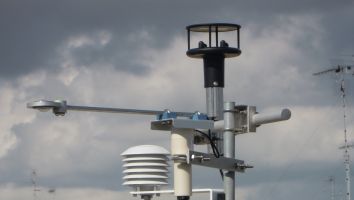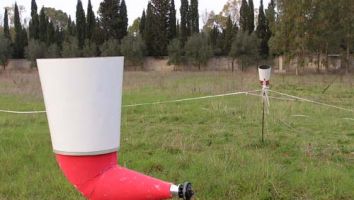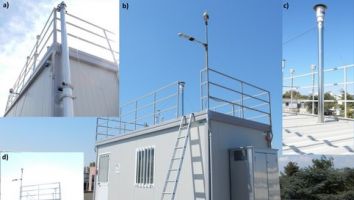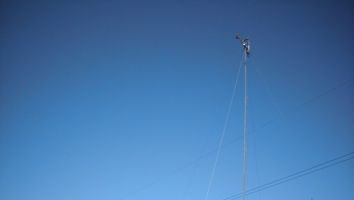Micrometeorological Station contact P.Martano
The micrometeorological station, operative from 2002, is intended to give complete information about the surface-atmosphere transfer of momentum, heat and water vapour (edddy covariance system for the turbulent fluxes ). It is composed by two units: atelescopic mast and an automated meteorological station. Telescopic mast with fast response instrumentation (16 meters) equipped with: A Solent-Gill 20 Hz ultrasonic anemomenter, one Campbell Kh20 Krypton hygrometerA surface temperature sensor Everest 4000.GL, A net radiometer (Siap-Micros Radnt), and a slow response thermohygrometer (Rotronic MP100). Automated meteorological station equipped with standard meteorological sensors and soil data sensors: Standard sensors: cup anemometer, thermohygrometer, global and net radiometers, rain gauge, barometer. Soil sensors are devoted to collect temperature, moisture and heat flux data at 2 levels underground: 2 thermistor temperature sensors (Campbell107L) 2 moisture content capacitive sensors (Decagon EC-5) 2 thermopile soil heat flux sensor (Hukseflux) At the station is active, since 2007, a MINISODAR for the measurement of the vertical profiles of the wind in the boundary layer. The measurements are transmitted via the GSM network to the central server at ISAC-CNR (UOS di Lecce). The data can be viewed in near real time on a web platform. Website
Sodar Station
This is a new system monostatic sodar (PC-MTSodar), based entirely on personal computer, capable of handling up to four antennas simultaneously, each operating at a different frequency. The system is versatile enough to function as sodar (low frequency) or Minisodar (high frequency) and minimizing external electronics makes it suitable for use in adverse environmental conditions. The system processing capabilities on-line and off-line and the signal from each antenna is digitized, filtered, decimated and analyzed separately on getting a 16-bit dynamic range of over 96 dB. The PC-MTSodar is able to detect wind speed profiles at high spatial and temporal resolution and this can be useful to analyze in detail the phenomena related to the dynamics of the boundary layer. The PC-MTSodar is formed by three antennas, one of which is oriented vertically, while the other two are tilted 22 degrees from the vertical. Each antenna is placed within vertices of a right triangle whose sides are about 30m each. The antenna beeps equal in length to each other 0.5s simultaneous frequency: 3350Hz, 3850Hz and 4350Hz with a repetition interval of 2s. In this configuration the minimum sampling is equal to 21 m above the ground level with a spatial definition equal to 15m. Website
Urban Meteorological Station contact A.Donateo
Urban Weather Station (AITeCH project) is operating in the old town, within the complex of the Ospedale dello Spirito Santo immediately adjacent Porta Rudiae in Lecce (40 ° 21' 3''N - 18 ° 9 '44''E). The weather station consists of an instrumented mast (2.3m) placed on the roof of the building (total height from the road, 14.2m). In total, the measurement station is composed by: A two-dimensional sonic anemometer (WindSonic) to measure the wind field on the instrumented mast. Unlike electro-mechanical anemometers this type of instrument does not have blind spots in detection of the direction and speed does not have a threshold below which the measures become unreliable. The absence of moving parts eliminates the need to calibrate the airspeed indicator on the field and makes it ideal for long-term studies. A slow thermo hygrometer (CS215, Campbell Scientific) to measure the temperature and relative humidity, a radiometer (Micros TRADNT V) for the measurement of net radiation. A rain gauge ARG100. The measurement system is a tipping bucket (contact closure). The diameter of the catchment is 254 mm. The resolution is 0.2 mm All sensors are interfaced to a datalogger (CR200, Campbell Scientific) for storage of data continuously. The datalogger is connected to a mini PC that allows you to have a remote control and weather station with a GSM system to transfer data to our central server to ISAC-CNR and are available on this website address






